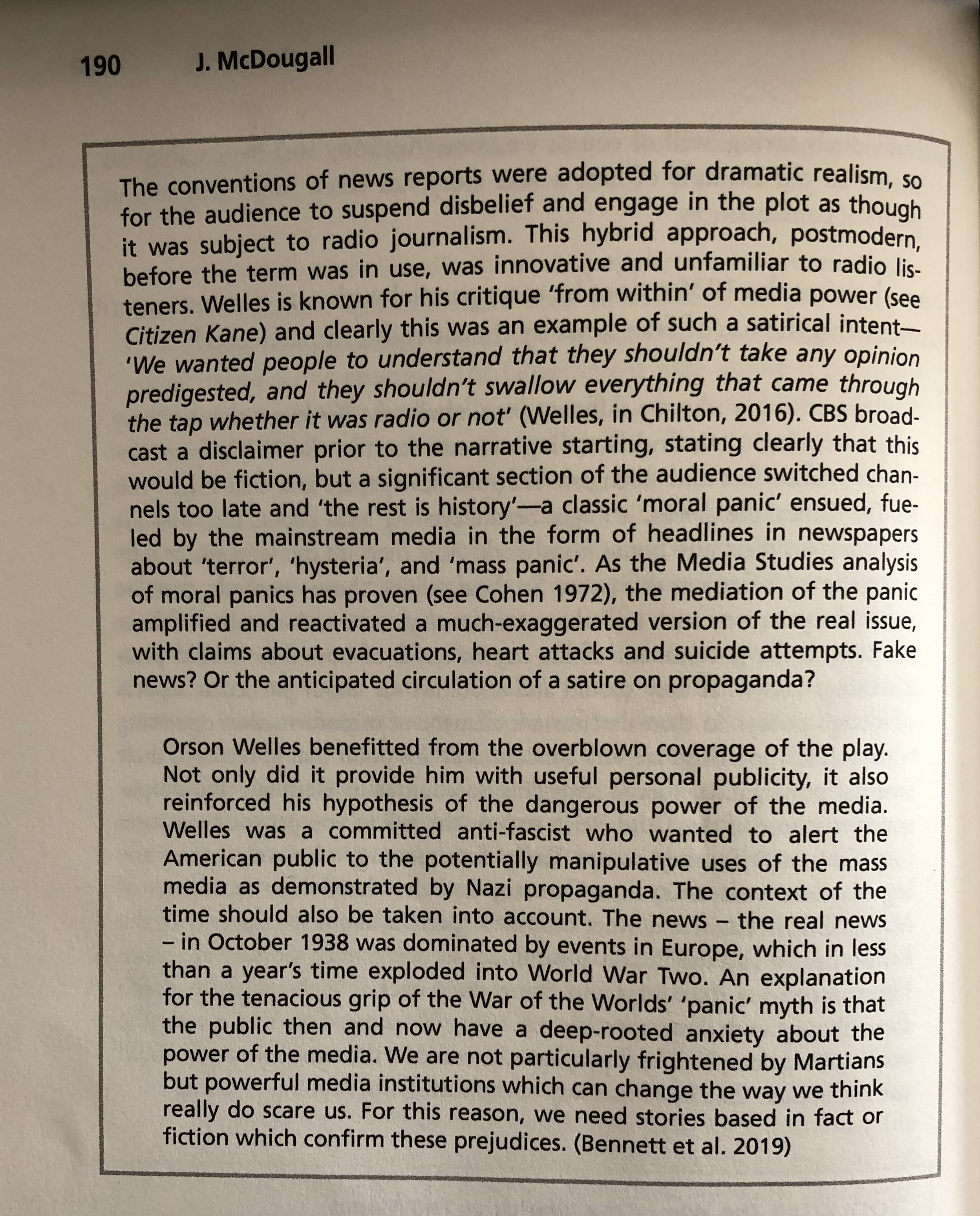-Poorer audio quality, longer more elaborate vocabulary to explain facts, maybe hinting towards the downfall of English language and understanding in correlation to the rise of technology.
-In relation to media industries, radio at this time was directly in competition to newspapers- therefore signifying the beginning of the public sphere diminishing throughout society (Habermas). This is due to major broadcasts being regulated to all over the worlds taking over the newspapers displaying everybody’s viewpoint,
-Power of media; if society turned there back to media broadcasts and products how much knowledge would we hold about modern day situations from around the world- ultimately holding media in a high power giving the question “can we trust it?”. We can correlate this to the fact that the media we consume can manipulate stories with their power and with the rise of fake news we have to consume it to have some understanding with the realisation it may not be trustworthy.
-Representation: through the use of codes and conventions and cross media techniques (conversations and music playing) they present this sci-fi broadcast as something that can seem real, steave neals theory of genre can be used to analyse how war of the news became so successful- with the new age of technology they provide entertainment with a repertoire of unique and different codes and conventions.
Specific signifiers of social class can be linked with Wyndhem-Goldies quote “transforming time and space”, suggesting radio opens a new world of knowledge to the public, such as agriculture and language- therefore maybe considering that radio was a help for the poorer uneducated people to gain knowledge about the world.
-In referral to audiences, you can argue that radio opened up a world of education to different genders, backgrounds and classes. For example the fight of feminism would still be apparent during this time, and via stereotypical/reactionary gender roles women would stay at home and be less educated by the men who were the workers. The women who stayed at home could listen in to the radio and gain more knowledge maybe creating fear over the patriarchal society as it was a gateway for change.
-Radio being a place for education as this was in the “golden age”, one could suggest that this broadcast was the earliest ideal of fake news as lesser educated people would listen in and maybe not understand the idea of satiricalism, or sci-fi fiction.
-With the cultivation theory via gerbner, specifically focussing on the mean world index, radio would be broadcasting about the hardships that the world was heavily going through during this time, audiences therefore perceiving the world as bad. In combination with the sci fi talking about fictional wars- the potential of misinformation drastically increases as it would be predictable for more bad things to manifest throughout society.
-Owned by columbia broadcatsing company that still exists to this day
– the broadcasts progressed through the story of an alien invasion on mars, and ends with “is anyone on air” continued with no response, this elaborate story telling in addition to cultivation theory can shock specific viewers as while radio opened a whole new world, some of the uneducated could be in belief of this sci fi, no one was harmed through this broadcasts, but it is one of the earlier manifestations of fake news.
-Halls reception theory can show the different ways the broadcast can be encoded, in combination with lasswells hyperdemic model that later was adapted by shannon and weaver, we can analyse the fact there were many different ways people could encode the message, or providing error and disruption.
-There’s a suggestion of many panic and pandemonium caused upon the public from the broadcast however can we really trust this? How do we know it wasn’t a production issue to entice more people to use radio? A publicity stunt? Link back to trust topic.
-Hall reception theory
-The main topic about this scp is the idea on what media is truthful and what is not, the emergence of the public fear from the broadcasts displayed on sights today such as Wikipedia suggest the public was heavily influenced and fearful, yet the documentary produced by radiolab about war of the worlds mention that 98% of surveyed audience weren’t listening to the broadcast and the 2% that did said they understood it wasn’t a news broadcast, the fear was mainly influenced via the newspaper suggesting mass pandemonium. through the decade newspaper and radio were in direct competition with each other and there was a fear of emerging technology- the newspaper producing this negative reaction yet not backed up with evidence could be newspaper trying to emerge above radio? Was this the early development of fake news? and if it is still used in sights today explaining the fear then are we active consumers at all? We have no 100% proof of either side being completely reliable or valid which also correlates with the amount of power media has and the trust that passive consumers would have in it, think Laswell’s hypodermic model of passive consumption.
Expanding on this produces two questions; was the development of new technology good or bad? Habermas talks about the public sphere which was clearly diminished throughout the development of new technology ultimately resulting in audiences becoming increasingly passive- which supports this being bad. Yet also it transformed the world and provided education into all backgrounds, leading to movements to achieve equality today- expanding our intelligence and viewpoint, our communication through everywhere in the world- Which would suggest it was a good thing.
George Welles the producer of the broadcast performed a public apology, there are claims say people were threatening to shoot him, and burning down news stations. He seemed threatened yet is this reliable.



